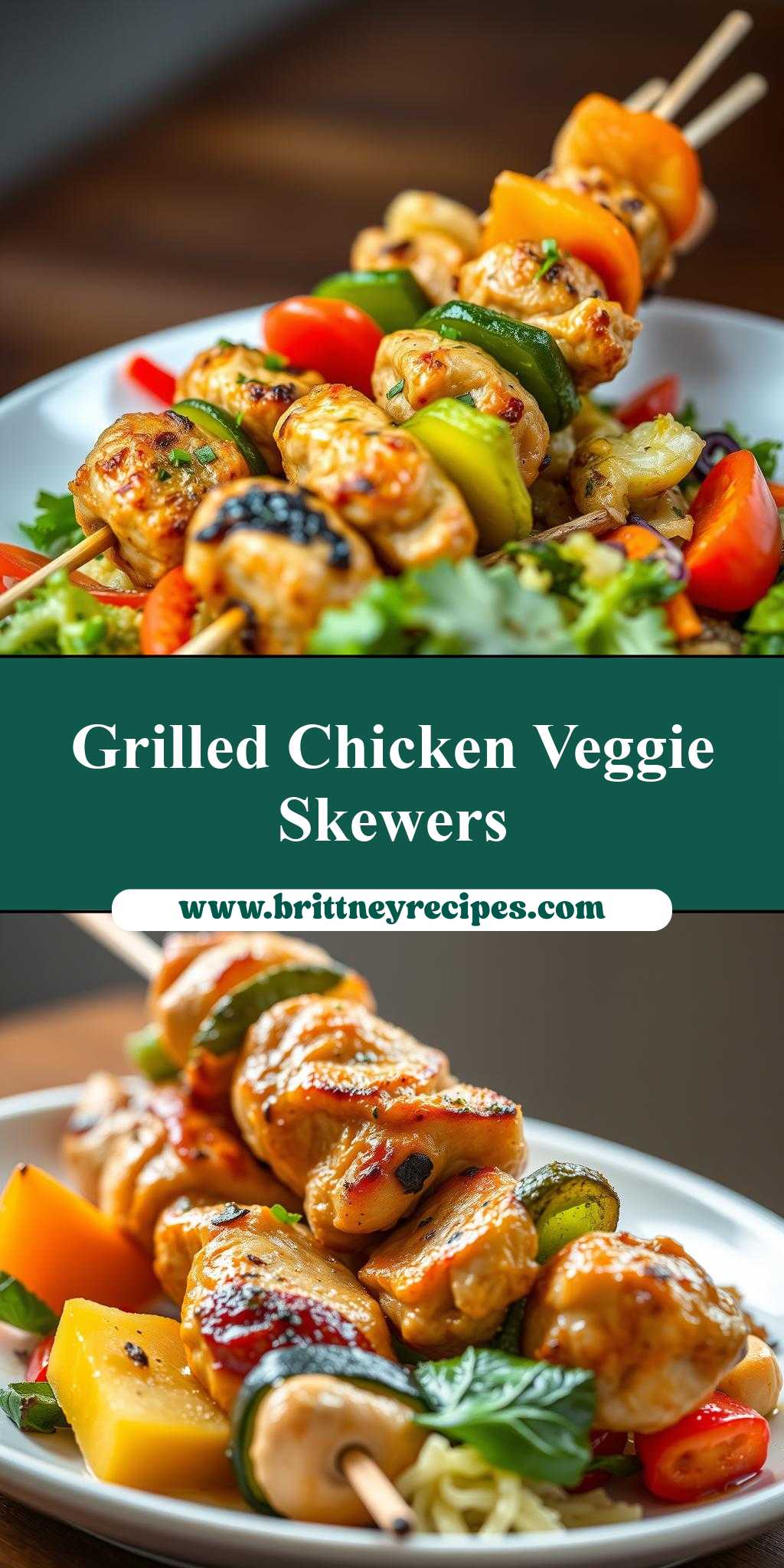What’s the secret to a perfect weeknight dinner? It all starts with these quick and easy chicken and vegetable skewers, loaded with marinated chicken and colorful bell peppers, perfect for a homemade family favorite – save this idea for a deliciously stress-free evening meal
Chicken and Vegetable Skewers
Introduction
Imagine a dish that’s not only easy to make but also bursts with flavor and color, perfect for any occasion, from a quick weeknight dinner to a festive outdoor gathering. Chicken and Vegetable Skewers are just that – a versatile, healthy, and incredibly tasty meal that can be customized with your favorite ingredients. The beauty of this recipe lies in its simplicity and the freedom to get creative with everyday ingredients, making it a staple for anyone looking to spice up their meal routine without breaking the bank or spending hours in the kitchen.
Why This Works
- Flavor balance and ingredient accessibility: This dish strikes a perfect balance between the savory flavor of chicken and the sweetness of various vegetables, all of which are easily found in most supermarkets.
- Ease of preparation: The skewers are incredibly simple to prepare, requiring minimal cooking skills and just a few basic kitchen tools.
- Impressive results with minimal effort: Despite the ease of preparation, the final product looks and tastes impressive, making it perfect for entertaining guests or a special meal for the family.
Key Ingredients
The main ingredients for Chicken and Vegetable Skewers include boneless, skinless chicken breasts, cut into bite-sized pieces; a variety of colorful vegetables such as bell peppers, zucchini, cherry tomatoes, onions, and mushrooms; olive oil for brushing; and your choice of seasonings, which could range from simple salt, pepper, and garlic powder to more complex marinades involving soy sauce, lemon juice, and herbs like thyme or rosemary. Practical substitutions can be made based on personal preference and dietary needs – for example, using tofu or portobello mushrooms for a vegetarian option, or swapping olive oil with avocado oil for a different flavor profile.
Instructions
- Step 1: Begin by prepping your ingredients. This involves cutting the chicken and vegetables into similar-sized pieces to ensure even cooking, measuring out your seasonings, and mixing any marinade ingredients you plan to use.
- Step 2: If using a marinade, place the chicken pieces in a bowl, pour the marinade over them, cover the bowl with plastic wrap, and refrigerate for at least 30 minutes to allow the flavors to penetrate the meat. Meanwhile, prepare your vegetables by brushing them lightly with oil and sprinkling with salt and pepper.
- Step 3: Thread the marinated chicken and vegetables onto skewers, leaving a little space between each piece to allow for even cooking. Brush the grill or grill pan with oil to prevent sticking, then cook the skewers over medium-high heat, turning occasionally, until the chicken is cooked through and the vegetables are tender and lightly charred.
- Step 4: Once the skewers are cooked, remove them from the heat and let them rest for a few minutes. Serve hot, garnished with fresh herbs if desired, and accompanied by your choice of sides, such as quinoa, couscous, or a simple green salad.
Handy Tips
- Soak wooden skewers in water for at least 30 minutes before threading to prevent them from burning during cooking.
- Don’t overcrowd the skewers, as this can lead to uneven cooking and a less appealing presentation.
- Experiment with different seasonings and marinades to find your favorite flavor combinations.
Heat Control
When cooking the skewers, it’s essential to maintain a medium-high heat to achieve a nice char on the outside while ensuring the chicken is fully cooked. The ideal internal temperature for cooked chicken is 165°F (74°C). Use a meat thermometer to check for doneness, especially if you’re unsure. Signs of doneness also include the chicken feeling firm to the touch and the juices running clear when cut.
Crunch Factor
The crunch factor in Chicken and Vegetable Skewers comes from the slightly charred exterior of the vegetables and the crispy edges of the chicken. To achieve this, make sure not to overcook the skewers. A slight tenderness with a crunch is perfect. For an extra crispy exterior, you can finish the skewers under the broiler for a minute or two, watching carefully to avoid burning.
Pro Kitchen Tricks
- Use a variety of vegetables to add texture and color to the dish. Including a mix of soft (bell peppers, onions) and firmer (cherry tomatoes, mushrooms) vegetables provides a pleasing contrast.
- For easier cleanup, line the grill pan or baking sheet with aluminum foil before cooking the skewers.
- Let the skewers rest for a few minutes before serving. This allows the juices to redistribute, making the chicken and vegetables more tender and flavorful.
Storage Tips
- Leftover skewers can be stored in an airtight container in the refrigerator for up to 3 days. Reheat gently in the microwave or oven until warmed through.
- For longer storage, consider freezing the cooked skewers. Place them in a single layer in a freezer-safe bag or container and store for up to 2 months. Reheat from frozen, adding a bit more cooking time as needed.
- When storing, it’s a good idea to keep the skewers intact to preserve their appearance and make reheating easier.
Gift Packaging Ideas
While Chicken and Vegetable Skewers are typically served fresh, they can also make a thoughtful and healthy gift, especially when paired with a side of quinoa or a salad. Consider packaging cooled skewers in a decorative container or bag, accompanied by a simple reheating instruction and a side of your favorite sauce or dressing. For a more rustic presentation, wrap individual skewers in parchment paper or aluminum foil and tie with a ribbon, perfect for a picnic or outdoor event.
Flavor Variations
- Different spices: Try using cumin and chili powder for a Mexican-inspired flavor, or go for an Indian twist with garam masala and cayenne pepper.
- Creative toppings: Serve the skewers with a dollop of tzatziki sauce, a sprinkle of feta cheese, or a side of peanut sauce for added creaminess and flavor.
- Ingredient swaps: Substitute chicken with shrimp for a seafood version, or use tofu and tempeh for vegetarian and vegan options.
Troubleshooting
- Texture problems: If the chicken is dry, it may have been overcooked. Try reducing the cooking time or using a meat thermometer to ensure it reaches a safe internal temperature without overcooking.
- Ingredient replacements: If a particular vegetable is not in season or available, feel free to substitute with another of similar texture and flavor profile.
- Over/undercooking signs: Keep an eye on the skewers while they cook. Undercooked chicken will feel soft and squishy, while overcooked chicken will be dry and hard. Vegetables should be tender but still crisp.
FAQs
- Can I freeze it? Yes, cooked skewers can be frozen for up to 2 months. Reheat from frozen, adjusting cooking time as needed.
- Is it gluten-free? This recipe is naturally gluten-free, making it a great option for those with gluten intolerance or sensitivity.
- Can I double the recipe? Absolutely. Simply multiply all the ingredients by two and cook in batches if necessary, to prevent overcrowding the grill or grill pan.
Conclusion
Chicken and Vegetable Skewers are a true culinary delight, offering a perfect blend of ease, flavor, and nutritional value. Whether you’re a seasoned chef or a beginner in the kitchen, this recipe is sure to become a favorite. Don’t be afraid to experiment with different ingredients and seasonings to make the dish your own, and enjoy the process of creating a meal that’s both healthy and delicious. With its versatility and appeal, Chicken and Vegetable Skewers are an excellent choice for any meal, from casual dinners to special occasions, and are sure to impress both family and friends alike.

